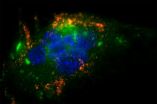(Press-News.org) After decades of fretting about population explosion, scientists are pointing to a long-term hidden global menace.
The household. More specifically, the household explosion.
In this week's Early Online edition of Population and Environment, Jianguo "Jack" Liu, director of the Michigan State University Center for Systems Integration and Sustainability, and former students Mason Bradbury and Nils Peterson present the first long-term historical look at global shifts in how people live. One large household sheltering many people is giving way across the world to households comprised of fewer people – sometimes young singles, sometimes empty nesters, and sometimes just folks more enamored with privacy.
In the late 1960s, ecologist Paul Ehrlich of Stanford University sounded the alarm about population growth. Now, Liu and his colleagues are pointing out that even though population growth has been curbed, the propensity to live in smaller households is ratcheting up the impact on the natural resources and the environment worldwide.
"Long-term dynamics in human population size as well as their causes and impacts have been well documented," said Liu, who is the Rachel Carson Chair in Sustainability. "But little attention has been paid to long-term trends in the numbers of households, even though households are basic consumption units."
More households require more lumber and other building materials. Smaller households are generally less efficient, with fewer people using proportionally more energy, land and water. Liu, with Ehrlich and others, published a paper in Nature in 2003 noting that the number of households globally was outpacing population growth between 1985 and 2000.
The latest research delves significantly further into history. Reviewing data dating back to 1600, the researches revealing that household size has been declining in some countries for centuries, adding a largely unaccounted for nuance to human's impact on the environment. In this paper, Liu and his colleagues call for households to be more centrally included in calculating human's impact on the environment, and caution against thinking that slowing population growth is a cause for celebration.
Average household size in developed countries declined rapidly from approximately 5 members in 1893 to 2.5 at present, while the rapid decline in average household size in developing nations began around 1987. The number of households grew faster than population size in almost every country and every time.
"We've documented that the changes we're seeing in household size across the globe essentially doubles the number of homes needed per-capita," Peterson said. "This will put enormous strain on the environmental life support system we rely on, even if we achieve a state of zero population growth."
The researchers point out that the environmental footprint becomes more of a trail. The new homes usually eventually require more roads, more yards and more commercial development.
INFORMATION:
Peterson is associate professor of forestry and environmental resources at North Carolina State University (NCSU). He has co-authored the new book "The Housing Bomb" with Liu and Tarla Peterson, professor of wildlife and fisheries science at Texas A&M University. Bradbury is a master's student at the University of Montana.
The research is supported by the National Science Foundation, MSU, and NCSU.
Population bomb may be defused, but research reveals ticking household bomb
2014-02-11
ELSE PRESS RELEASES FROM THIS DATE:
Implementing an advance care planning program in German nursing homes
2014-02-11
In the 1990s advance care planning (ACP) developed as an alternative to the traditional approach to creating advance directives. In contrast to the traditional approach, the ACP concept views advance health care planning as a lifelong communication process. All persons in a target group are actively offered professional facilitation. Furthermore, the relevant institutions and professionals are involved and receive regular training and updates. They thus assume responsibility for ensuring that newly written advance directives are relevant, valid, available when needed, and ...
A breast cancer drug to fight fungal disease?
2014-02-11
The drug tamoxifen appears to kill a fungus associated with a deadly brain infection that afflicts HIV/AIDS patients, according to a University of Rochester study published online today by mBio, the journal of the American Society for Microbiology.
The findings, by Damian J. Krysan, M.D., Ph.D., associate professor of Pediatrics and Microbiology and Immunology at the UR School of Medicine and Dentistry, point to an example of Rochester researchers looking to repurpose older drugs by discovering new applications for secondary properties of the drug. In this case, investigators ...
A new postal code for cancer
2014-02-11
This news release is available in German.
Scientists have discovered that a polymer can provide a key to get into tumors: Prof. Prasad Shastri, Director of the Institute of Macromolecular Chemistry and core member of the cluster of excellence BIOSS Centre for Biological Signalling Studies at the University of Freiburg, and graduate students Julia Voigt and Jon Christensen have developed a new paradigm to home nanoparticles, containers that measure a few 100 nanometers in size, to endothelial cells. Using just charged polymers with the right affinity for cell lipids ...
Urban bees using plastic to build hives
2014-02-11
Once the snow melts, Canada's bee population will be back in business -- pollinating, making honey and keeping busy doing bee things. For at least two urban bee species, that means making nests out of plastic waste.
A new study by a University of Guelph graduate and a U of G scientist reveals that some bees use bits of plastic bags and plastic building materials to construct their nests. The research was published recently in the journal Ecosphere.
It's an important discovery because it shows bees' resourcefulness and flexibility in adapting to a human-dominated world, ...
MIT robot may accelerate trials for stroke medications
2014-02-11
The development of drugs to treat acute stroke or aid in stroke recovery is a multibillion-dollar endeavor that only rarely pays off in the form of government-approved pharmaceuticals. Drug companies spend years testing safety and dosage in the clinic, only to find in Phase III clinical efficacy trials that target compounds have little to no benefit. The lengthy process is inefficient, costly, and discouraging, says Hermano Igo Krebs, a principal research scientist in MIT's Department of Mechanical Engineering.
"Most drug studies failed and some companies are getting ...
First observation of a human HAT, key proteins in numerous pathologies
2014-02-11
The researcher Manuel Palacín, head of the Heterogenic and Multigenic Diseases lab at the Institute for Research in Biomedicine (IRB), in Barcelona, is among the world's experts in HATs (heteromeric amino acid transporters).
In humans, there are eight HAT molecules. These are associated, for example, with the following: rare diseases called aminoacidurias, such as lysinuric protein intolerance and cystinuria; the development of infections caused by the Kaposi sarcoma virus; various types of cancer; and relapse in cocaine use. HATs are, as the name implies, amino acid ...
Rare cancers: the challenge of accurate diagnosis -- press release
2014-02-11
Brussels, Belgium, 11 February 2014 -- Inaccurate diagnosis is a major obstacle for the proper treatment of patients with rare cancers. A Consensus on Improving the Pathologic Diagnosis of Rare Cancers was presented today by RARE CANCERS EUROPE, together with the European Society for Medical Oncology (ESMO) and the European Society of Pathology (ESP) in Brussels. The recommendations aim to help rare cancer patients get a timely and accurate diagnosis.
The statement is the result of a two-day workshop, where the particular challenges for each type of rare cancer(1) were ...
Could statins be used to fight a deadly viral infection?
2014-02-11
Two Perelman School of Medicine microbiologists may have found a way to use statins, the well-known blockbuster cholesterol-lowering drugs, to fight the hantavirus, a mysterious and lethal microorganism that appeared suddenly in the US southwest over 20 years ago. That first outbreak led to the deaths of more than a dozen people, most of them in their prime. The last reported outbreak happened in Yellowstone Park in 2012.
Only about 30 known human cases of hantavirus are reported in the US each year. The respiratory syndrome caused by a hantavirus infection comes from ...
Hacking the environment: bringing biodiversity hardware into the open
2014-02-11
New technologies are changing the way we collect biodiversity data. Data that once required taking expensive, bulky and fragile equipment on field trips can now be collected on cheap, compact and robust devices. In a recent paper in the Biodiversity Data Journal the construction of an environmental data-logger using the Arduino platform is described. It is hoped that this work will encourage the adoption of new data collection technologies by biodiversity scientists and foster new collaborations with both electronics hobbyists and electronics engineers who have an interest ...
Exon skipping prevents formation of toxic protein fragments in Huntington's disease
2014-02-11
New Rochelle, NY, February 11, 2014—An innovative therapeutic strategy for reducing the levels of toxic protein fragments associated with Huntington's disease uses a new approach called exon skipping to remove the disease-causing component of the essential protein, huntingtin. Proof of concept using antisense oligonucleotides to "skip over" the specific exon in a mouse model of Huntington's disease is reported in an article in Nucleic Acid Therapeutics, a peer-reviewed journal from Mary Ann Liebert, Inc., publishers. The article, part of a special focus issue on exon skipping, ...



